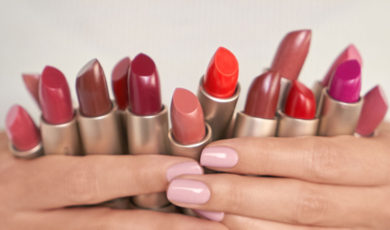The Complete Dos and Don’ts of At-Home Salon Services

The inability to hit the salon for your twice-monthly manicure or routine cut and color — combined with a certain inevitable boredom that comes from sitting at home 24/7 — is a recipe for potential beauty-gone-wrong scenarios. It’s also potential for some truly therapeutic, self-care moments. To ensure you end up in the latter category, follow this expert advice on navigating common “at-home salon” scenarios.

Hair
While there’s no shame in gray roots or split ends, we understand a desire to keep up with your existing cut and color. Doing so becomes particularly daunting if you have a higher-maintenance hairstyle such as bangs or layers, or a hair color that’s starkly different from your natural shade. That said, you do have some options.
At-Home Haircuts
Your first and best option is to let your hair grow out, making sure to take good care of your locks with a quality hairbrush, deep conditioners, scalp masks and heat protectants. Your second option is to attempt a micro-cut.
“Doing a simple clean-up on the ends can be done at home if you have a loved one nearby who’s willing to help with the job,” says celebrity hairstylist Bradley Leake. “I call this a micro trim because this is just a little trim of the ends — usually less than a quarter inch. [To pull this off], section out hair from the ear forward and cut 1/4-inch of hair using very sharp scissors.”
As for bangs, growing them out may be the best option for now, as well. However, if you absolutely must cut them, then take it slowly and methodically. Leake says the best approach is to style your hair per usual, then section your bangs into an upside-down triangle with the widest part being the fringe.
“Use a wide-tooth comb so there is no tension on the hair, and keep the bangs flat to your forehead so they don’t end up being too short,” he says. “Then, keeping the scissors vertical, cut into the hair starting at the center and working your way to the edges until the desired length is reached. I like to slightly taper the edges for a softer blend. Remember, less is more.”
At-Home Coloring Advice
If you have plans to hit your salon in the future, your best option is to use temporary, semi-permanent, or other mild color treatments. One option, says Tiffanie Richards, a master colorist for Nunzio Saviano Salon, is an at-home gloss.
“If you usually get your hair colored in-salon and have highlights, I would strongly encourage you to ask your colorist their thoughts on at-home glosses for you. If you don’t have any color on your hair and just want to richen or shine up your natural color, this is also a great option,” says Richards. “A gloss I personally recommend for my clients is by Kristen Ess, and can be purchased from Target. She is a colorist herself, and understands the simplicity that needs to be in an at-home color product. They come in a wide variety of tones and, for the most part, are a pretty simple, in-shower process.”
For grays or otherwise aggressive roots, you can try a temporary root spray, says Leake. His two favorites are Color Wow Root Conceal Powder (simply brush onto the hair in the morning) or Rita Hazan Root Spray (ideal for those who are 75% gray). R+Co Bright Shadows and L’Oreal Root Cover Up are two additional options.
What Not to Try at Home
If you’ve got time on your hands, it’s a great time to play with your look. That said, our pros advised that first-timers avoid…
· Going blonde (or lighter in general) — this is a recipe for orange locks
· Going red, which will most likely look very artificial, as creating the perfect red is especially complicated
· Cutting layers into your hair
· DIY highlights
· Drastic haircuts

Skincare
Investing in your skincare regimen at this time will improve the overall health of your skin and can also serve as a time to unwind and practice self-care.
“Your first step is knowing your skin type, which is very important when selecting the best products to care for your skin. Regardless of your skin type, there are four simple steps you can do at home to maintain great skin,” says Dr. Michele Green, a board-certified cosmetic dermatologist. Those steps are: cleansing twice daily, applying a treatment product, using a moisturizer and wearing sunscreen.
“Your treatment product should contain salicylic acid or glycolic acid if you are acne prone, or an anti-aging treatment product such as vitamin C in the morning and tretinoin or retinol at night,” says Dr. Green. “Regarding moisture, all skin types need moisture to maintain the acid mantle of the skin. Moisturizing also helps to nourish and replenish our skin cells.”
A couple times a week you can give yourself an at-home facial. The steps are similar to your everyday regimen, only you may use a more aggressive treatment and really double-down on hydrating, soothing products. For instance: cleansing, toning, using a strong treatment such as a glycolic acid or enzyme mask, followed by nourishing serums, oils and creams.
What Not to Try at Home
Certain salon or dermatological treatments can be downright dangerous if they aren’t performed by a trained professional. We miss our facialist and our derm too, but Dr. Green strongly advises to avoid the following (and we wholeheartedly agree!):
· Professional-grade chemical peel — this can cause severe burns and scarring
· At-Home microneedling — these tools are hard to clean, which increases risk for infection, and they can be misused and cause more harm than good
· Extractions — this can traumatize the skin and lead to scarring and infection

Nails
Celebrity manicurist Mazz Hanna thinks it’s a great time to give your hands and nails a break from gels, dips and acrylics. She says, “I recommend making a simple and easy DIY hand scrub using two parts sugar, one part coconut oil. Simply rub it into your hands and rinse off with warm water. Your hands will be smooth and hydrated. You can also use a cuticle oil 2-3 times a day.”
As for tending to existing gels, dips, and acrylics, you have two primary options: let them grow out and trim/buff them down, or soak them off. The latter may be easier to deal with (and prevent you from doing long-term damage — we’ll get to that).
“You can safely and effectively remove your gels and dip nails at home, as long as you have the correct tools: foil, cotton, acetone, nail file, cuticle pusher and buffer,” says Hanna. “File your nails into a thin layer (the more you file, the less time it’ll take to soak), soak a cotton ball with acetone and place on your nail, then tightly wrap it with aluminum foil. After about 10 minutes, remove the foil and scrap the product away with a cuticle pusher. Gently buff away any excess product and then shape with a file.”
For simple, healthy-looking nails, you can paint with a fortifying nail polish, or you can try press-ons which can be easily removed when you want, and won’t damage your real nails.
What Not to Try at Home
· Picking at your gels/dips/acrylics —this can cause damage that’ll last many, many months
· Clipping your cuticles — unless you’re a pro, you could hurt yourself
Waxing
If you’ve ever thought to yourself, “Wow, I really wish I didn’t have to wax regularly,” now is the time to embrace that feeling and… let it grow. If you’re in the camp that still wants it gone, you do have some options.
“For hair that is getting especially wild, trimming is a better option than shaving because you’re not risking razor bumps or irritation.” says Amber Wendel, a waxing expert and corporate trainer for LunchboxWax. “As far as at-home waxing goes, I’ve heard way too many horror stories to recommend it with a good conscience. Your waxologist might make waxing look like a breeze, but we’ve worked on our technique and we have a clean, safe environment that a microwaved wax just can’t compare to. Not to mention, we’re not all professional yogis who can wax our own hard-to-reach areas.”
Switching to trimming also means you circumvent the whole ingrown hair fiasco. If you forego the above advice and DO decide to wax, the best way to prevent ingrowns is to moisturize regularly and use a chemical exfoliator or physical salt scrub on the area.
As for brows, Wendel also recommends the “let it grow” approach. You can go in with tweezers to eliminate scraggly bits, but otherwise just embrace your hair. The good news is that natural, bushy brows are in and it’ll give you a chance to reset your look anyway. Please, please avoid at-home wax in this area in particular, since it’s too easy to burn yourself (or actually wax off an entire brow!).
So, whatever your calendar usually holds, the bottom line is: this spring, embrace growth, give your body time to rest, and really practice some TLC. And when you finally do get to see your beauty pro at the salon, make sure to give them kudos for the craft they’ve mastered and their ability to help you look your best.





